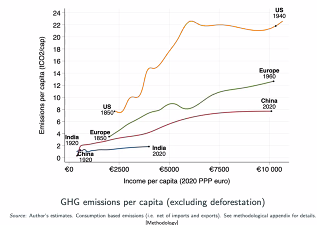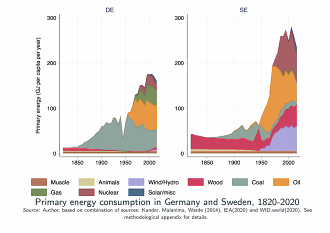Carbon and Inequality in the Long Run (1820-2020)
Seminar notes
Disclaimer: These notes are circulated for the joy of sharing research that I find interesting and stimulating. I hope that they can be helpful to you as well. Please, keep in mind that the present document has not been reviewed by the author(s). They could thus contain errors and/or approximations. Before citing the reported results, please, make sure to check the latest publicly available release.
Carbon and Inequality in the Long Run (1820-2020)
Some facts on climate change
CO2 concentration
Current CO2 concentration levels are the highest in 14 million years. Last time there was a similar CO2 concentration, temperature was 10° higher.
GHG concentration
Historically, there has been variations in GHG concentration but the recent period is characterised by a large overshoot - unprecedented in the last 10k years
Temperature
Last 2000 yrs, avg global temperature ~14° C. Some variations but overall stable until now. Currently, we are 1.3°C above the late 19th avg global temperature.
Flows of Greenhouse Gases (GhG) emissions
60 megatons in 2020 vs 10 megatons in 1900. Today, energy is the bulk of those emissions. 2/3 of GHG goes for GHG.
What is left
800Gt left before 2°C - independent of the peak oil.
- Would correspond to 1t CO2 e per person per year until 2100. Order ofmagnitude: Paris-NYC=1.4t per passenger, average per year per person (world)=7t.
Energy systems shaped by diversity of historical trajectories, political choices matter a lot (1820-2020)
Long run per capita emissions across nations
Largely differ from one place to another. US and Western Europe are very different while income levels in GB and the US are close.
Growth and C02
For the same level of income per capita, there are very different levels of emission per capita.

Conceptual distinction
- Primary energy: total amount of fuels consumed for human and economic processes. This is what matters to the planet.
- Useful energy: amount of fuel after conversion into useful energy by tech.
Energy “transition”
We have seen some sort of transitions, but no disappearance. Coal has not disappeared, consumption stoped growing. Same for oil.
Energy Growth Consumption
As human-being, we are using approx 4x more energy today than 200 years ago, world average. Large difference from 1 country to another.
Energy efficiency is a product of both endowments and political choices
Abundance of labor in Europe made capitalism more energy efficient
US production is energy inefficient, less labor intensive than Europe, bargaining power from the coal community is larger in Europe-> coal was thus more socially and economically costly in Europe than in the US.
Automobile “politics”
Europe imposed stringent regulations(DE: SPD heavily taxed automobiles, FR: early regulations to limit speed & pollution, UK: public opinion resistance to auto pollution noise and danger). Much faster automobile growth in the US in the pre-war era.
Diverging trajectories within Europe

The SE example (vs DE): Because of energy independence, SE kept firewood much longer than other European countries.
It’s not just about endowment, but also about political forces. E.g. in the US, there was a joint effort from the oil and car industry to limit the outcome of the Truman momentum to support solar power and decentralized energy production. LC: the role of politics has been undermined.
Global carbon pollution is highly concentrated role of asset ownership (1970-2020)
Since the 1990s, carbon emissions are computed at the national level -> challenged by globalisation and asset ownership. Largely under the radar.
Input/Output work
Leontief inversion allows you to know the content of any sector of the economy or even good. It appears that developed countries import carbon while developing countries export some. In the end, this is not so dramatic.
Strong inequality in net emissions, key roles of investments
At the top of the distribution, investments play large role in individual carbon emissions.